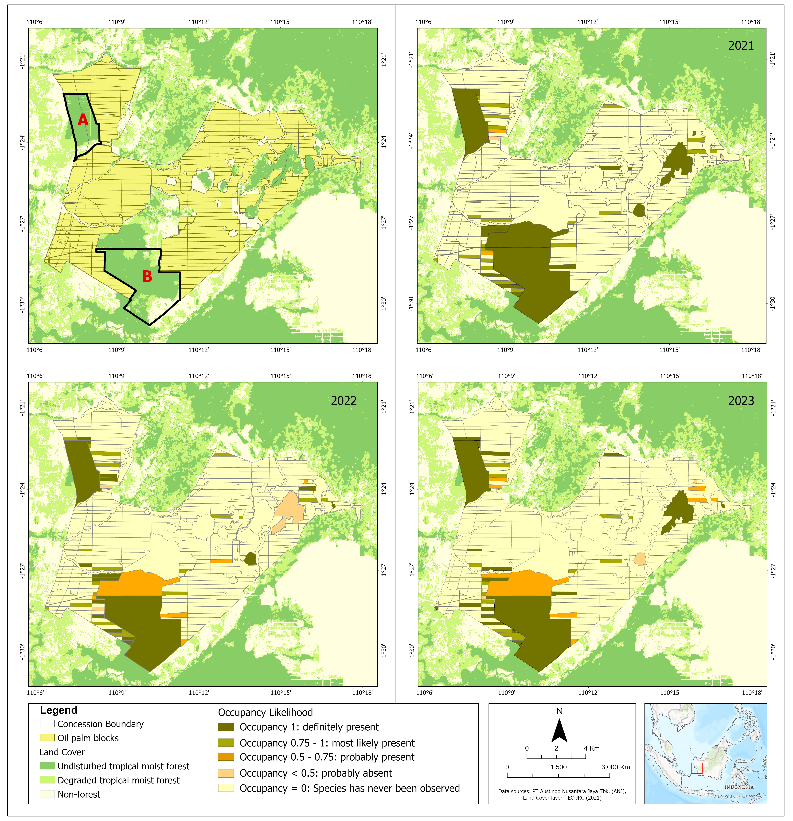A Novel, Low-cost Biodiversity System for Sustainable Oil Palm
Agricultural expansion is ongoing, and so is an ever-increasing overlap between agricultural land and natural habitats. Traditionally, this overlap has been viewed as an unavoidable threat to biodiversity. However, recent findings suggest that, with proper management, species can thrive in agricultural landscapes. This presents an opportunity to transform biodiversity monitoring systems into ones that embrace coexistence, enhance ecosystems, and support business performance without compromising sustainability.
A recent study by Maharani et al. examines such a system: PENDAKI, a pilot project developed by Borneo Futures for Austindo Nusantara Jaya (ANJ), in Indonesia. This citizen science-based monitoring program relies on plantation workers to collect biodiversity data during their daily tasks. The information gathered helps the company track species trends, understand habitat use, and inform conservation strategies within palm oil estates.
Since 2019, PENDAKI has recorded over 148,000 wildlife observations across seven estates, contributed by approximately 3,950 participants. Unlike traditional biodiversity surveys, which are often conducted by external experts and remove data from those working in the field, PENDAKI engages on-site staff directly. This not only democratizes data collection but also fosters a sense of ownership and pride among participants.
Interviews with PENDAKI contributors revealed that workers felt greater appreciation for biodiversity and valued being part of a company that prioritizes sustainability. Many reported gaining knowledge of species names, conservation statuses, and the importance of protecting wildlife.
Why Presence Alone Isn’t Enough
Understanding species abundance—not just their presence—is crucial for effective biodiversity management. It is very difficult to adaptively manage wildlife if you only look at species presence. What you need instead is an indicator of abundance, how this varies over time, and why. This allows an estate manager to plan and budget appropriate habitat and threat management to maintain wildlife populations of high conservation value.
PENDAKI employs special models designed for opportunistically collected wildlife observation through non-systematic surveys. These models account for imperfect detection and biases in data collection. The resulting data allow researchers to track species populations over time and measure biodiversity trends through the Living Plantation Index (LPI)—an estate-specific wildlife diversity index.

Figure. Living Plantation Index for PT KAL, Kalimantan, Indonesia, showing an increase in wildlife abundance and richness from 2020 to 2024, in this case combining data from 60 wildlife species. Baseline year 2020 = index value 100.
The data can also be used spatially. For example, orangutans were observed not only in protected forests but also in oil palm blocks (see map below), highlighting the need for wildlife corridors. Meanwhile, species like the White-breasted Waterhen showed higher occupancy in planted areas, challenging assumptions about wildlife distribution in agricultural settings.

Figure. An example of the use of occupancy statistics for orangutans derived from PENDAKI.
A Cost-Effective Model for Conservation
One of PENDAKI’s biggest advantages is its affordability. The program costs just USD 0.14 per hectare annually, far less than traditional wildlife surveys or surveys using drones or camera traps. This makes it a scalable and financially viable approach to biodiversity monitoring.
Conclusion
This study demonstrates that citizen science can revolutionize biodiversity monitoring in oil palm plantations. By leveraging the power of local engagement, companies can gather valuable ecological data, support conservation, and strengthen their sustainability commitments—all while keeping costs low. If you want to know more about potential implementation in your company, feel free to reach out to us at emeijaard@borneofutures.org.
For more information on the work of Borneo Futures, visit www.borneofutures.org.